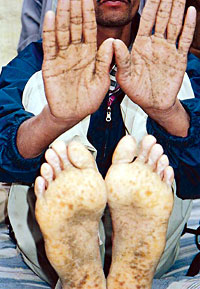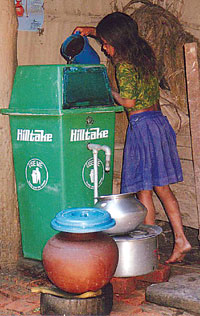 For years, Nepalis in the tarai have been drinking groundwater from tube wells dug in their backyards. Millions of such wells were built worldwide in the 1970s by well-meaning development groups, which thought they were safer than drinking surface water and would reduce the time spent to fetch water. Few people questioned the groundwater, which looks as clean as piped water, is available at all times and tastes sweet.
For years, Nepalis in the tarai have been drinking groundwater from tube wells dug in their backyards. Millions of such wells were built worldwide in the 1970s by well-meaning development groups, which thought they were safer than drinking surface water and would reduce the time spent to fetch water. Few people questioned the groundwater, which looks as clean as piped water, is available at all times and tastes sweet.
Then in 1999, the UN's World Health Organisation (WHO) and our Department of Water Supply and Sanitation (DWSS) conducted a survey in parts of the tarai, which concluded that arsenic contamination in groundwater might be a serious problem. After a series of large-scale studies, it is now estimated that more than three million Nepalis are drinking arsenic tainted water.
Arsenic is a naturally occurring element found in groundwater, in Nepal mostly in the tarai. Long-term exposure to this poison leads to diseases such as melanosis (dark and light spots on the skin), keratosis (hardening of the skin on hands and feet), vascular diseases, birth defects and even lung cancer and kidney problems.
Nawalparasi, Rupandehi, Kapilbastu, Bardiya, Kailali, Rautahat, Bara and Parsa are the tarai districts most affected by arsenic contamination. Its concentration in tubewell water of these districts was found to be 2 to 20 times greater than Nepal's interim guideline of 50ppb (parts per billion) and 10 to 100 times greater than the WHO guideline of 10ppb.
"From skin disease to risk to the reproductive health of women, the problems caused by long-term exposure to arsenic contaminated water are unpredictable. It is a serious public health concern that cannot be ignored," says Makhan Maharjan, program manager at the Environment and Public Health Organisation (ENPHO), a Nepali NGO devoted to science and technology and raising awareness of environmental issues.
ENPHO has devised a local solution to this grave problem, which affects millions of people in the Gangetic plain, including 35 million Bangladeshis. Working with researchers from the Massachusetts Institute of Technology (MIT) and NGO Rural Water Supply and Sanitation Support Program (RWSSSP) its researchers have devised an affordable household drinking water filter made from ingredients found in any local bajar.  The Kanchan Arsenic Filter uses simple technology to remove arsenic, pathogens, iron, turbidity, odour and other contaminants from water. A round plastic bin is filled with layers of sand, brick, chips, gravel and iron nails, which chemically bind arsenic to them. When water is poured from the top, larger pathogens are trapped on top of the sand layer and smaller ones are removed by hungry micro organisms.
The Kanchan Arsenic Filter uses simple technology to remove arsenic, pathogens, iron, turbidity, odour and other contaminants from water. A round plastic bin is filled with layers of sand, brick, chips, gravel and iron nails, which chemically bind arsenic to them. When water is poured from the top, larger pathogens are trapped on top of the sand layer and smaller ones are removed by hungry micro organisms.
"This technologically user friendly filter is a result of many years of research," says Tommy Ngai, research associate at Canada's Centre for Affordable Water and Sanitation Technology and a consultant with ENPHO. The Kanchan filter's flow rate is 15-20 litres per hour and operated for 12 hours a day at 15 litres per hour it can produce 180 litres of water. The WHO recommends that each person have a minimum of 5.5 litres per day to meet their basic health and hygiene needs.
The filter's price, after transportation and profit, is Rs 1,400-1,800. "The Kanchan Arsenic Filter comes with the best technology available, at the most affordable price for arsenic free water," says Madhav Pahadi, project officer at UNICEF's children and women environment section.
ENPHO received $ 70,000 in grants from Holland's Simavi Foundation. The Kanchan Arsenic Filter also won the US Environment Protection Agency's P3 competition and the Wall Street Journal's Technology Innovation Award 2005. ENPHO installed 3,000 filters last year and plans to add 5,000 in the next two years.
Vulnerable Valley
Almost 50 percent of the Kathmandu Valley's total water supply comes from groundwater sources. A joint study done by the JICA Expert Office at the Ministry of Physical Planning and Works (MPPW) and ENPHO in September 2005 found that deep tube wells in the Valley were more vulnerable to arsenic contamination than shallow tube wells and dug wells. "While shallow wells were found more contaminated in the tarai region, the case was exactly the opposite in Kathmandu," says ENPHO's Makhan Maharjan. The project sampled 137 private, government and Nepal Water Supply Corporation (NWSC) deep tube wells (at least 50 metres deep) during both the monsoon and pre-monsoon seasons. The highest concentration of arsenic (265ppb) in Kuleswor was observed during pre-monsoon while 211ppb was recorded in the same area during monsoon. "If you are using groundwater in Kathmandu, we suggest you have it tested first for arsenic before drinking it," says Maharjan. Groundwater can be tested in testing labs like the one at ENPHO, for as little as Rs 50.


